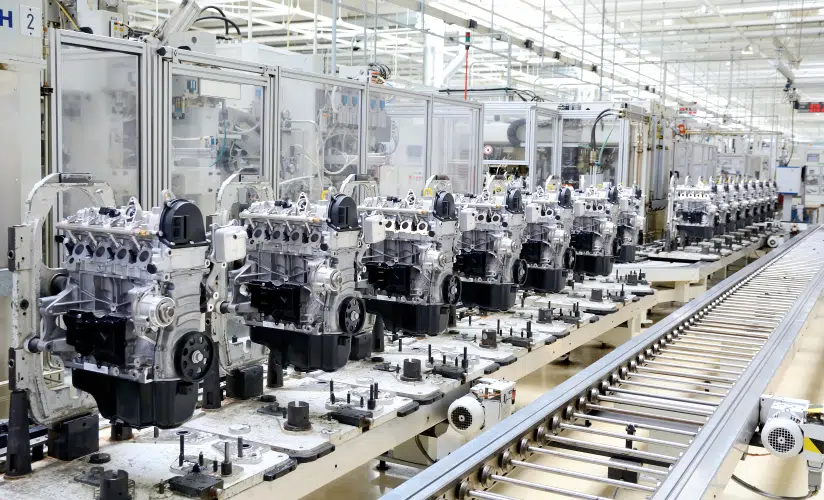Assembly of aggregate carriers & floor conveyor technology
Automotive engineering solutions from WinMOD
Assembly of aggregate carrier (MAT)
Pre-assembly of axle carriers, chassis, steering and drive units
Conveyor technology and assembly stations
The conveyor technology for transporting the unit carriers consists mainly of roller conveyors, chain conveyors, rotary tables and lifting tables. These are the same elements used in classic SKID systems. The WinMOD-SIMLINE system provides a comprehensive 3D conveyor technology library with all the necessary conveyor modules. These can be freely configured in terms of size and shape, allowing you to create a virtual model of your system with millimetre precision.
In contrast, the actual assembly and handling stations are highly individual, depending on the vehicle model to be manufactured or specialised production know-how. To integrate these stations, you import their 3D CAD design data directly into the WinMOD-SIMLINE 3D Editor. There, you kinematise the station axes and integrate 3D sensors, such as light asters, proximity switches or scanners, directly into the virtual 3D station model. With these real-time sensors, the MATs with all their mechanics are captured with precise contours.
For virtual commissioning (VC), connect the 3D station model with virtual drive, pneumatic and hydraulic modules that simulate control-relevant behaviour and PLC communication in real time. The modules are available in extensive WinMOD libraries.


generator set
The aggregate carriers (MAT for short) are undoubtedly the central elements of this technology. Just like the assembly stations, they are highly customised modules. They usually contain various mechanical components such as screwdrivers, clamping devices and longitudinal adjustment mechanisms.
In WinMOD-SIMLINE, MATs are therefore created directly from the original 3D design data. To do this, you can import and edit many different CAD formats in our 3D editor. How detailed the internal mechanics of the MAT are simulated is entirely up to you. To test larger conveyor and buffer sections, a simple MAT transport frame for transport and accumulation processes may be sufficient. However, when it comes to the interaction of a MAT in an assembly station, every single mechanical component is important. For this purpose, the screwdriver axes, clamps and longitudinal adjustment are kinematised.
With VC, you can run virtual MATs through the system and test your conveyor technology and station controls in real time. The mechanical coupling and sensor detection between the station and MAT are simulated realistically.
floor conveyor technology
Conveyor systems for component supply and product removal.
Component and Pallet Conveying Systems
This term covers virtually all floor conveyor technology that is not SKID-based. It refers to standard roller conveyors, belt conveyors and plate conveyors, some of which are used in very large conveyor systems for component supply or product removal. With the WinMOD-SIMLINE 3D libraries, you can easily create your layouts from straight lines, curves, lift tables, transfer carriages and turntables. In addition, various 3D sensor types are available, which you can virtually mount and align on the conveyors just as you would in a real system.
The individual components and assembly pallets are integrated via CAD import. In the 3D simulation, these are then transported, stowed and stacked in real time. This provides you with all the aspects you need for a realistic virtual commissioning (VC) of your automation system. You can test the PLC software as well as the loading and unloading of components or the return cycle of empty pallets.


Plate conveyor in final assembly
A special form of floor conveyor technology is used in final assembly. These plate conveyors are sunk into the hall floor so that their transport surface is flush with the hall floor. The cars to be transported are almost finished and stand on their own wheels. WinMOD-SIMLINE also provides 3D library elements for this special technology, which include the special positioning and circulation behaviour. In combination with virtual positioning drives, this results in a highly accurate real-time simulation of this technology.
Clamping blocks for wheel fixation and reflectors are also available, as are 3D sensors. Here, too, the cars can be integrated via CAD import.
At the VC, you finally commission your plant PLC and test the precise transfers at the conveyor edges with many virtual cars.
Further automotive engineering solutions
Production area in which structural body parts and outer skin parts are produced from sheet metal coils or cut-to-size blanks (blanks) by cold or hot forming – from the raw blank to the ready-to-install formed part.
Assembles stamped/formed sheet metal parts, extruded and cast components into a dimensionally accurate body structure – with defined geometry, rigidity, crash and NVH performance as the basis for the paint shop and final assembly.
Highly automated plant chains for surface pre-treatment, coating and curing of car bodies and add-on parts – designed for high throughput, reproducible appearance and corrosion protection.
Pre-assembly of front/rear axle modules as carriers for chassis, steering and drive units such as combustion engines, powertrains or electric axles. Transport to the sequenced handover to the „marriage“ with the body.
Highly automated process chain for the fabrication of traction batteries – from electrode production to cell assembly and forming to module/pack assembly
This area of technology encompasses conveyor systems that transport and sort pallets and mesh boxes containing automotive components. The conveyor elements are large roller and chain conveyors combined with lifting, rotating and shifting tables.
Fully automated high-bay warehouses, which are operated by light or heavy-duty storage and retrieval machines and controlled by distributed automation systems. Warehouse management systems generate the orders for storing and retrieving raw components or complete car bodies.
Ground-based conveyor technology in which car bodies or heavy modules are transported on standardised SKIDs (steel frames with vehicle-specific support points) through assembly, paint shop and buffer areas.
Overhead conveyor systems with electrically driven, individually controllable trolleys on monorail tracks for low or high loads (up to tonnes).
Ground-based conveyor technology in which car bodies or heavy assemblies are moved on platforms along rails. The drive is typically provided by friction wheels, push chain conveyors or push beams, which continuously push the SKIDs forward.